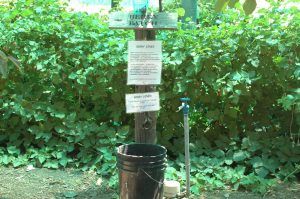Berries for the Home Garden
We are all familiar with the thorny brambles that grow along roads, in watercourses and seasonal drainages, and at the edges of parking lots. Known as Himalayan blackberry (Rubus armeniacus); left uncontrolled, these brambles form impenetrable thickets. The California Invasive Plant Council (Cal-IPC http://www.cal-ipc.org/) rates it as severe in its impacts on plant communities and ecosystem processes.
However, there are many varieties of berries that are available (and more manageable) for home gardeners than these introduced, invasive brambles. In addition to blackberries, the category of berries includes strawberries, raspberries and blueberries.
Blackberries: Many garden variety blackberry cultivars are available to add to your edible landscaping. Boysenberries, ollalieberries and Marionberries are all types of blackberries that are available for home gardening. Beware: blackberry shoot tips that arch over and touch the ground can root in the fall.
Raspberries grow best in coastal areas with cooler temperatures where they can grow in full sun. They come in varieties that are red, yellow, purple or black. My red raspberries came to me from another Master Gardener as starts from original plants that grew in Santa Cruz. Even with regular drip irrigation and shade cloth covering them, they suffered and burned in last summer’s 110-degree heat in Jamestown!
Talk to your favorite nursery to find out what cultivars might do better in our area. At lower elevations in the Sierra foothills, raspberries will need supplemental water. Some Master Gardeners recommend a mist system to mitigate our lower-elevation summer heat.
Blueberries are members of the Ericaceae (heath) plant family that contains heathers, azaleas and rhododendrons. These plants prefer acidic soil and tend to grow in infertile soils in Northwestern rain forests and mountain habitats. Various kinds of blue berries are native in circumpolar regions, with some wild varieties growing in the Eastern U.S. as far south as North Carolina. These native blueberries require higher amounts of “chilling hours” (cold winter temperatures) than are available in California. Work at various universities has gone into developing a type of blueberry called southern highbush that can better tolerate the warmer temperatures and fewer chilling hours in California.
Before planting blueberries, check the acidity of the soil. Simple test kits can be purchased at plant nurseries and garden stores. According to the California Garden Web http://cagardenweb.ucanr.edu/ “The blueberry variety you select for your garden will depend on where you live in California. Most nurseries make it a point to carry cultivars that have been tested and do well in your area.”
Strawberries are a delicious favorite in the summer. Strawberry cultivars are either short-day or day-neutral. Short-day types are also called June-bearers and produce a large crop in spring. Day-neutral types produce fruit spring through fall. Again, talk to your favorite nursery person to find out what cultivars are best adapted to your growing area.
For more information about growing and caring for berries, come to the University of California Cooperative Extension Master Gardeners of Tuolumne County Open Garden Day and Plant Sale on Saturday, April 7, from 10 -1. The master gardener demonstration garden is located on the Cassina High School campus at 251 South Barretta Street in downtown Sonora. Free information presentations begin at 10:30, rain or shine.
Rebecca Miller-Cripps is a University of California Cooperative Extension Master Gardener of Tuolumne County who grows red raspberries and tries to tame Himalayan blackberries in Jamestown.
UCCE Master Gardeners of Tuolumne County can answer home gardening questions. Call 209-533-5912 or go to: http://ucanr.edu/survey/survey.cfm?surveynumber=7269 to fill out our easy-to-use problem questionnaire. Check out our website at: http://cecentralsierra.ucanr.edu/Master_Gardeners/ You can also find us on Facebook.

